Incorporating an ERP in HCM for Goal Seek Company HRM80015
VerifiedAdded on 2020/05/11
|18
|3974
|79
Report
AI Summary
This report analyzes the implementation of an Enterprise Resource Planning (ERP) system in Human Capital Management (HCM) for Goal Seek (GS) Company, focusing on addressing challenges in managing human resources. The report begins with an executive summary and introduction, outlining the aim, scope, methodology, and limitations. It then provides background information, problem analysis, and a project proposal to convince the CEO of the benefits of implementing an HCM module within the existing ERP system. The report includes a stakeholder analysis, examining the impact on employees, HR management, and clients. It also offers an organizational and financial fit analysis, projecting costs, savings, and return on investment. The report addresses risk analysis and proposes an implementation strategy, culminating in a conclusion that supports the integration of the ERP system to enhance efficiency, reduce costs, and improve accountability in human capital management. The report utilizes a six-step problem-solving model and includes a literature review to support its findings.
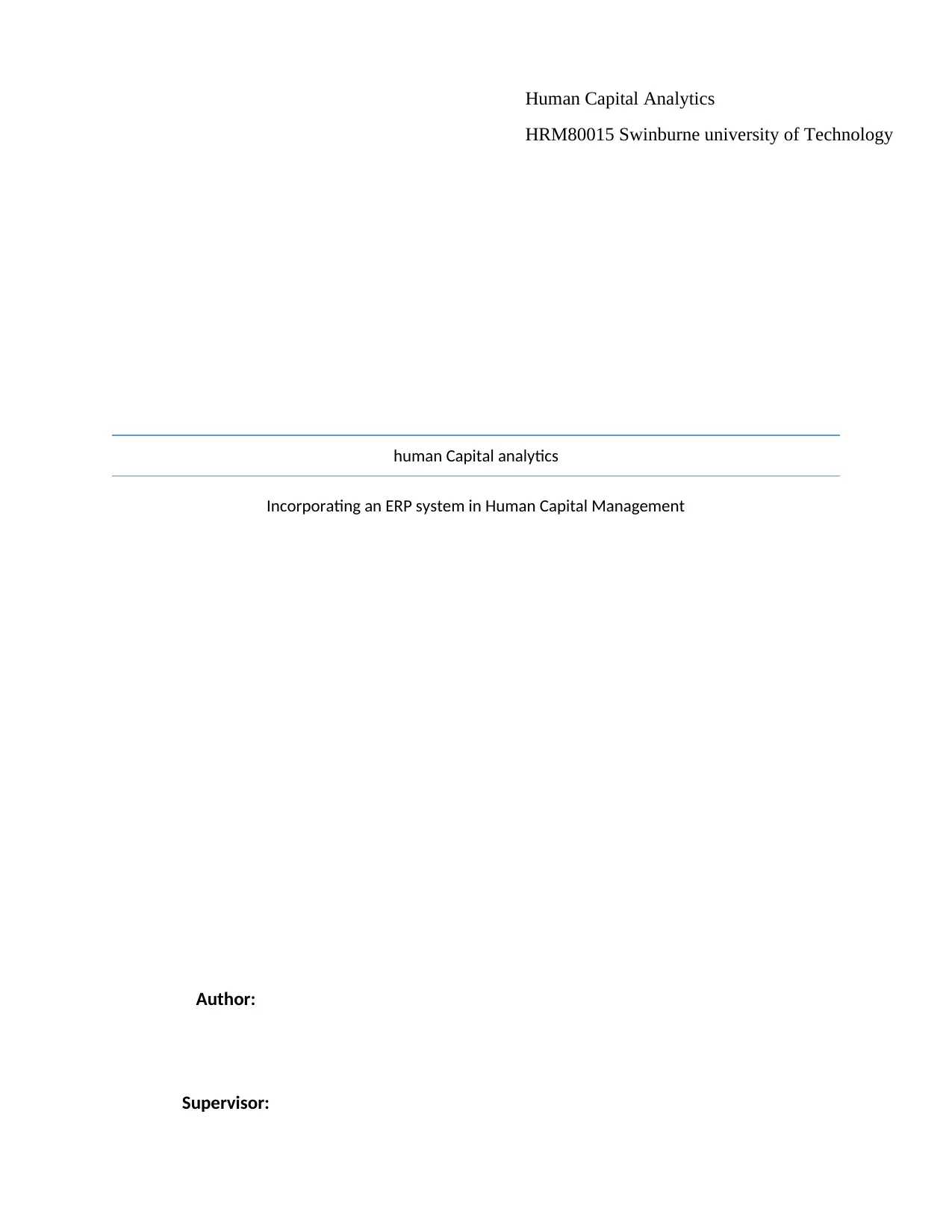
human Capital analytics
Incorporating an ERP system in Human Capital Management
Author:
Supervisor:
Human Capital Analytics
HRM80015 Swinburne university of Technology
Incorporating an ERP system in Human Capital Management
Author:
Supervisor:
Human Capital Analytics
HRM80015 Swinburne university of Technology
Paraphrase This Document
Need a fresh take? Get an instant paraphrase of this document with our AI Paraphraser

Executive Summary
Goal Seek company has been experiencing challenges in management in its human resources
functions. After several research conducted on the issues at hand, it has been identified that lack
of an ERP system is the main cause of the issues. GS Company has sought to install an ERP
system for the purposes of addressing the challenges. This report aims at explaining the
challenges at hand and why it’s necessary to implement the system.
Table of Contents
i
Goal Seek company has been experiencing challenges in management in its human resources
functions. After several research conducted on the issues at hand, it has been identified that lack
of an ERP system is the main cause of the issues. GS Company has sought to install an ERP
system for the purposes of addressing the challenges. This report aims at explaining the
challenges at hand and why it’s necessary to implement the system.
Table of Contents
i
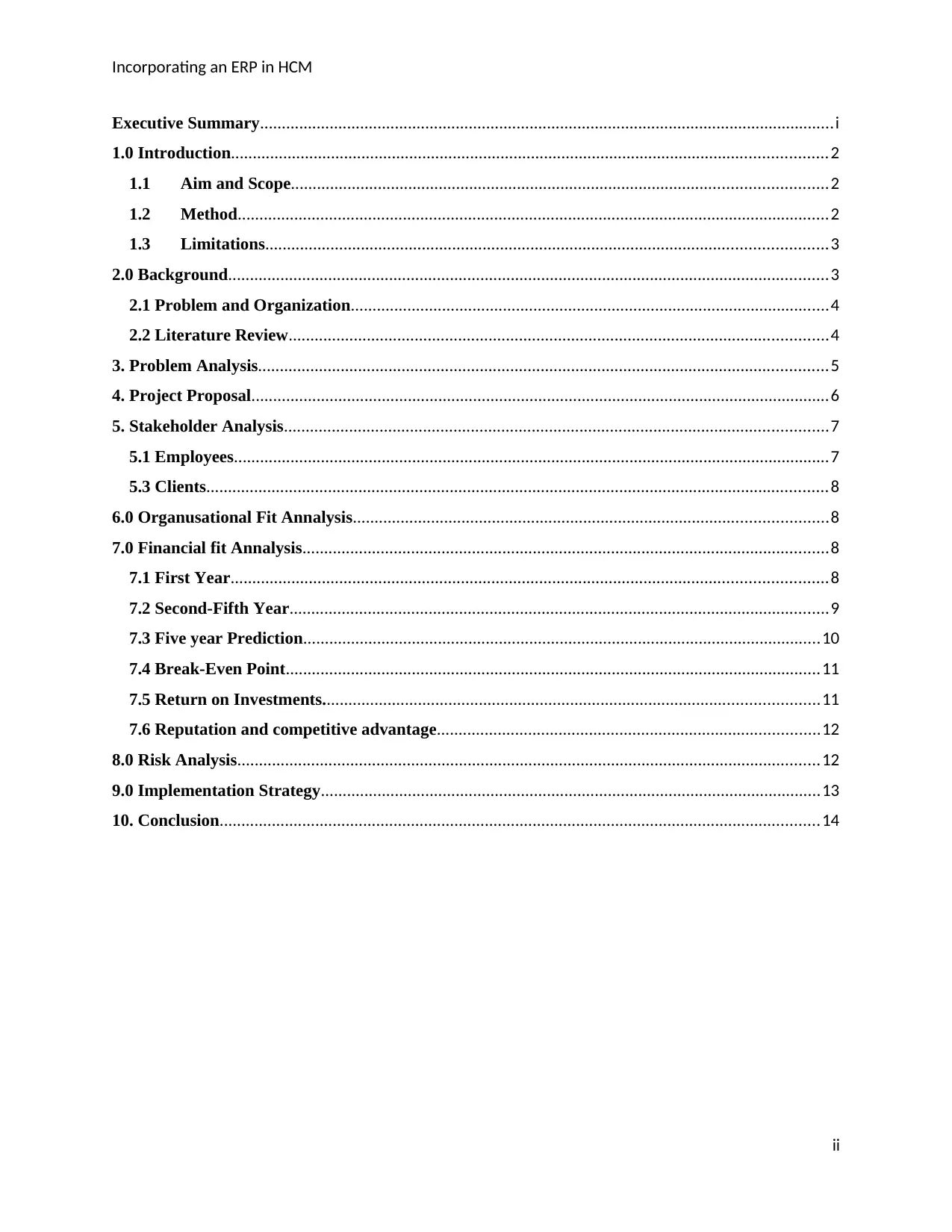
Incorporating an ERP in HCM
Executive Summary....................................................................................................................................i
1.0 Introduction.........................................................................................................................................2
1.1 Aim and Scope...........................................................................................................................2
1.2 Method........................................................................................................................................2
1.3 Limitations.................................................................................................................................3
2.0 Background..........................................................................................................................................3
2.1 Problem and Organization..............................................................................................................4
2.2 Literature Review............................................................................................................................4
3. Problem Analysis...................................................................................................................................5
4. Project Proposal.....................................................................................................................................6
5. Stakeholder Analysis.............................................................................................................................7
5.1 Employees.........................................................................................................................................7
5.3 Clients...............................................................................................................................................8
6.0 Organusational Fit Annalysis.............................................................................................................8
7.0 Financial fit Annalysis.........................................................................................................................8
7.1 First Year.........................................................................................................................................8
7.2 Second-Fifth Year............................................................................................................................9
7.3 Five year Prediction.......................................................................................................................10
7.4 Break-Even Point...........................................................................................................................11
7.5 Return on Investments..................................................................................................................11
7.6 Reputation and competitive advantage........................................................................................12
8.0 Risk Analysis......................................................................................................................................12
9.0 Implementation Strategy...................................................................................................................13
10. Conclusion..........................................................................................................................................14
ii
Executive Summary....................................................................................................................................i
1.0 Introduction.........................................................................................................................................2
1.1 Aim and Scope...........................................................................................................................2
1.2 Method........................................................................................................................................2
1.3 Limitations.................................................................................................................................3
2.0 Background..........................................................................................................................................3
2.1 Problem and Organization..............................................................................................................4
2.2 Literature Review............................................................................................................................4
3. Problem Analysis...................................................................................................................................5
4. Project Proposal.....................................................................................................................................6
5. Stakeholder Analysis.............................................................................................................................7
5.1 Employees.........................................................................................................................................7
5.3 Clients...............................................................................................................................................8
6.0 Organusational Fit Annalysis.............................................................................................................8
7.0 Financial fit Annalysis.........................................................................................................................8
7.1 First Year.........................................................................................................................................8
7.2 Second-Fifth Year............................................................................................................................9
7.3 Five year Prediction.......................................................................................................................10
7.4 Break-Even Point...........................................................................................................................11
7.5 Return on Investments..................................................................................................................11
7.6 Reputation and competitive advantage........................................................................................12
8.0 Risk Analysis......................................................................................................................................12
9.0 Implementation Strategy...................................................................................................................13
10. Conclusion..........................................................................................................................................14
ii
⊘ This is a preview!⊘
Do you want full access?
Subscribe today to unlock all pages.

Trusted by 1+ million students worldwide

1.0 Introduction
Goal seeks (GS) Company operates in the service industry and has grown exponentially in the
external audit sector over the last few years. Due to the market demand and increasing number of
employees, the company is experiencing internal issues in managing the human capital resource
of the company. GS has identified that by installing an extension of the existing company ERP
system to incorporate Human Capital management module, the company will benefit from saved
costs, efficiency and accountability with their human capital
Based on this, GS conducted a problem analysis and prepared a project proposal that will help
the company in the process.
1.1 Aim and Scope
This report aims to outline how the implementation of an ERP system in managing Human
Capital in the organization will achieve efficiency, cost saving and optimal utilization of
available employees of the company. The main goal of the report is to convince the Chief
Executive Officer of the company in implementing the Human Capital Management Module in
the ERP system of the company.
1.2 Method
The report will include a literature review that covers an analysis done on other projects,
textbooks, web contents, journals and case studies will be done. The six-step model of problem-
solving will be used in defining the problem and proposing solutions. The reports aim at building
credibility around efficiency and applicability. this is an information type of project which will
be a short and periodic report.
1
Goal seeks (GS) Company operates in the service industry and has grown exponentially in the
external audit sector over the last few years. Due to the market demand and increasing number of
employees, the company is experiencing internal issues in managing the human capital resource
of the company. GS has identified that by installing an extension of the existing company ERP
system to incorporate Human Capital management module, the company will benefit from saved
costs, efficiency and accountability with their human capital
Based on this, GS conducted a problem analysis and prepared a project proposal that will help
the company in the process.
1.1 Aim and Scope
This report aims to outline how the implementation of an ERP system in managing Human
Capital in the organization will achieve efficiency, cost saving and optimal utilization of
available employees of the company. The main goal of the report is to convince the Chief
Executive Officer of the company in implementing the Human Capital Management Module in
the ERP system of the company.
1.2 Method
The report will include a literature review that covers an analysis done on other projects,
textbooks, web contents, journals and case studies will be done. The six-step model of problem-
solving will be used in defining the problem and proposing solutions. The reports aim at building
credibility around efficiency and applicability. this is an information type of project which will
be a short and periodic report.
1
Paraphrase This Document
Need a fresh take? Get an instant paraphrase of this document with our AI Paraphraser
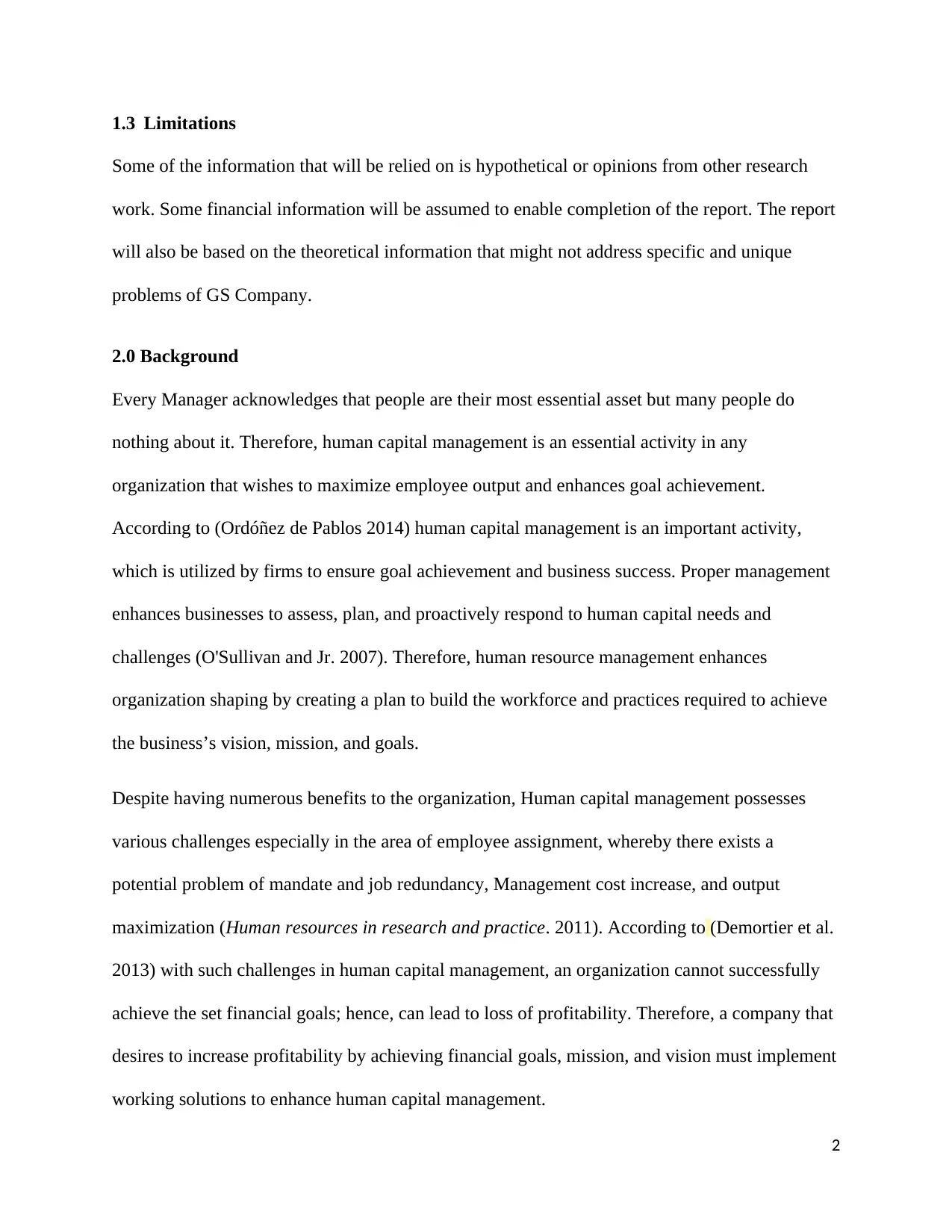
1.3 Limitations
Some of the information that will be relied on is hypothetical or opinions from other research
work. Some financial information will be assumed to enable completion of the report. The report
will also be based on the theoretical information that might not address specific and unique
problems of GS Company.
2.0 Background
Every Manager acknowledges that people are their most essential asset but many people do
nothing about it. Therefore, human capital management is an essential activity in any
organization that wishes to maximize employee output and enhances goal achievement.
According to (Ordóñez de Pablos 2014) human capital management is an important activity,
which is utilized by firms to ensure goal achievement and business success. Proper management
enhances businesses to assess, plan, and proactively respond to human capital needs and
challenges (O'Sullivan and Jr. 2007). Therefore, human resource management enhances
organization shaping by creating a plan to build the workforce and practices required to achieve
the business’s vision, mission, and goals.
Despite having numerous benefits to the organization, Human capital management possesses
various challenges especially in the area of employee assignment, whereby there exists a
potential problem of mandate and job redundancy, Management cost increase, and output
maximization (Human resources in research and practice. 2011). According to (Demortier et al.
2013) with such challenges in human capital management, an organization cannot successfully
achieve the set financial goals; hence, can lead to loss of profitability. Therefore, a company that
desires to increase profitability by achieving financial goals, mission, and vision must implement
working solutions to enhance human capital management.
2
Some of the information that will be relied on is hypothetical or opinions from other research
work. Some financial information will be assumed to enable completion of the report. The report
will also be based on the theoretical information that might not address specific and unique
problems of GS Company.
2.0 Background
Every Manager acknowledges that people are their most essential asset but many people do
nothing about it. Therefore, human capital management is an essential activity in any
organization that wishes to maximize employee output and enhances goal achievement.
According to (Ordóñez de Pablos 2014) human capital management is an important activity,
which is utilized by firms to ensure goal achievement and business success. Proper management
enhances businesses to assess, plan, and proactively respond to human capital needs and
challenges (O'Sullivan and Jr. 2007). Therefore, human resource management enhances
organization shaping by creating a plan to build the workforce and practices required to achieve
the business’s vision, mission, and goals.
Despite having numerous benefits to the organization, Human capital management possesses
various challenges especially in the area of employee assignment, whereby there exists a
potential problem of mandate and job redundancy, Management cost increase, and output
maximization (Human resources in research and practice. 2011). According to (Demortier et al.
2013) with such challenges in human capital management, an organization cannot successfully
achieve the set financial goals; hence, can lead to loss of profitability. Therefore, a company that
desires to increase profitability by achieving financial goals, mission, and vision must implement
working solutions to enhance human capital management.
2
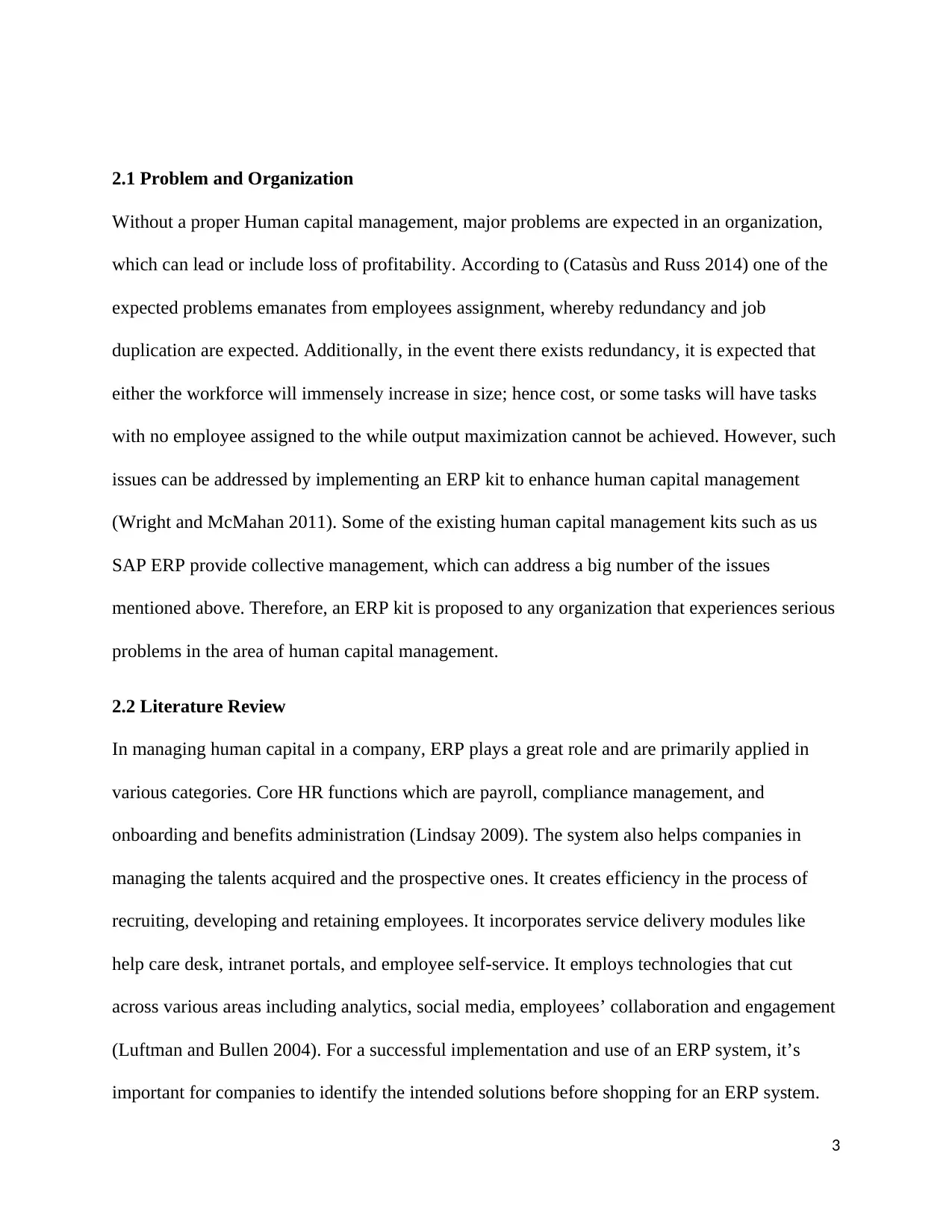
2.1 Problem and Organization
Without a proper Human capital management, major problems are expected in an organization,
which can lead or include loss of profitability. According to (Catasùs and Russ 2014) one of the
expected problems emanates from employees assignment, whereby redundancy and job
duplication are expected. Additionally, in the event there exists redundancy, it is expected that
either the workforce will immensely increase in size; hence cost, or some tasks will have tasks
with no employee assigned to the while output maximization cannot be achieved. However, such
issues can be addressed by implementing an ERP kit to enhance human capital management
(Wright and McMahan 2011). Some of the existing human capital management kits such as us
SAP ERP provide collective management, which can address a big number of the issues
mentioned above. Therefore, an ERP kit is proposed to any organization that experiences serious
problems in the area of human capital management.
2.2 Literature Review
In managing human capital in a company, ERP plays a great role and are primarily applied in
various categories. Core HR functions which are payroll, compliance management, and
onboarding and benefits administration (Lindsay 2009). The system also helps companies in
managing the talents acquired and the prospective ones. It creates efficiency in the process of
recruiting, developing and retaining employees. It incorporates service delivery modules like
help care desk, intranet portals, and employee self-service. It employs technologies that cut
across various areas including analytics, social media, employees’ collaboration and engagement
(Luftman and Bullen 2004). For a successful implementation and use of an ERP system, it’s
important for companies to identify the intended solutions before shopping for an ERP system.
3
Without a proper Human capital management, major problems are expected in an organization,
which can lead or include loss of profitability. According to (Catasùs and Russ 2014) one of the
expected problems emanates from employees assignment, whereby redundancy and job
duplication are expected. Additionally, in the event there exists redundancy, it is expected that
either the workforce will immensely increase in size; hence cost, or some tasks will have tasks
with no employee assigned to the while output maximization cannot be achieved. However, such
issues can be addressed by implementing an ERP kit to enhance human capital management
(Wright and McMahan 2011). Some of the existing human capital management kits such as us
SAP ERP provide collective management, which can address a big number of the issues
mentioned above. Therefore, an ERP kit is proposed to any organization that experiences serious
problems in the area of human capital management.
2.2 Literature Review
In managing human capital in a company, ERP plays a great role and are primarily applied in
various categories. Core HR functions which are payroll, compliance management, and
onboarding and benefits administration (Lindsay 2009). The system also helps companies in
managing the talents acquired and the prospective ones. It creates efficiency in the process of
recruiting, developing and retaining employees. It incorporates service delivery modules like
help care desk, intranet portals, and employee self-service. It employs technologies that cut
across various areas including analytics, social media, employees’ collaboration and engagement
(Luftman and Bullen 2004). For a successful implementation and use of an ERP system, it’s
important for companies to identify the intended solutions before shopping for an ERP system.
3
⊘ This is a preview!⊘
Do you want full access?
Subscribe today to unlock all pages.

Trusted by 1+ million students worldwide

Companies enjoy synergies of the system and better satisfaction in service delivery and
streamline major processes of the company.
3. Problem Analysis
A problem solving is the mental process followed by an individual while they have a problem
without an immediate solution to it. According to (TAYLOR 2016) the process should include
some cognitive processes; ascertain the problem, identify the cause and opportunities of reaching
the goal, generate creative solutions to the problem, evaluate and choose the best solution, and
finally implementing the best solution identified. Primarily, the problem in GS Company may
be identified as complexity in managing the human resources of the company. The solution
being sort is how to manage the human Capital adequately.
The six steps of problem-solving model explain that problems may vary widely, and so do their
solutions. The model is dynamic and able to handle different issues regardless f their conceptual
differences. The model accommodates diverse needs in the process of problem-solving. The
model will include the following steps:
1. Problem definition; after reviewing the issues at hand, the company identifies its
challenges (problem) to be ‘how to manage its human Capita adequately.’ This stage
involved digging deep into the issues at hand and determine the primary problem
involved. Mistaking symptoms for the problem is common. By identifying the right
problem, it helps in choosing the right solution to the identified problem.
2. Analyzing the problem; This stage involves narrowing down to the exact issues and the
effects thereof. GS has identified different problems with its Human Capital. There have
been issues with accounting for employees, controlling number of overtime worked,
delayed payroll processing and high associated costs. The company suffers inefficiency
4
streamline major processes of the company.
3. Problem Analysis
A problem solving is the mental process followed by an individual while they have a problem
without an immediate solution to it. According to (TAYLOR 2016) the process should include
some cognitive processes; ascertain the problem, identify the cause and opportunities of reaching
the goal, generate creative solutions to the problem, evaluate and choose the best solution, and
finally implementing the best solution identified. Primarily, the problem in GS Company may
be identified as complexity in managing the human resources of the company. The solution
being sort is how to manage the human Capital adequately.
The six steps of problem-solving model explain that problems may vary widely, and so do their
solutions. The model is dynamic and able to handle different issues regardless f their conceptual
differences. The model accommodates diverse needs in the process of problem-solving. The
model will include the following steps:
1. Problem definition; after reviewing the issues at hand, the company identifies its
challenges (problem) to be ‘how to manage its human Capita adequately.’ This stage
involved digging deep into the issues at hand and determine the primary problem
involved. Mistaking symptoms for the problem is common. By identifying the right
problem, it helps in choosing the right solution to the identified problem.
2. Analyzing the problem; This stage involves narrowing down to the exact issues and the
effects thereof. GS has identified different problems with its Human Capital. There have
been issues with accounting for employees, controlling number of overtime worked,
delayed payroll processing and high associated costs. The company suffers inefficiency
4
Paraphrase This Document
Need a fresh take? Get an instant paraphrase of this document with our AI Paraphraser

in these areas which further slows the company output and taints its image among the
clients.
3. Identify the possible Solution. Among the potential and suitable solution to the identified
problems, the company determines that incorporating an ERP system in its human capital
management tops the list.
4. Choosing the best solution; the company finds that implementing the ERP is the ultimate
choice for the company. The system will be the based on most of the company current
human resource problems.
5. Plan of Action. This stage examines the foreseeable timelines and costs in implementing
the project. The company intends to implement the ERP over a span of the next eight
months, with a deadline of June 2018 (end of financial year). This will be inline with
consultations held with the possible provider of the ERP system. The provider extends an
installment facility on the costs of the project based on deliverables.
6. Implementing the Solution. This stage involves medicating the company problems by
applying the solutions adopted. It will an ongoing process, and the company wil have to
strive in ensuring it works as planned. Goodwill from the stakeholders will be important
is this stage.
4. Project Proposal
After conceptualizing the issues at hand, GS has identified that the possible solution would be
implementing a workable Human Capital management system. It will help in maintaining
employees data, duty allocation and monitoring, accounting for actual worked hours, conducting
employee appraisals, processing of wages and salaries and will reduce on consulting fees for the
5
clients.
3. Identify the possible Solution. Among the potential and suitable solution to the identified
problems, the company determines that incorporating an ERP system in its human capital
management tops the list.
4. Choosing the best solution; the company finds that implementing the ERP is the ultimate
choice for the company. The system will be the based on most of the company current
human resource problems.
5. Plan of Action. This stage examines the foreseeable timelines and costs in implementing
the project. The company intends to implement the ERP over a span of the next eight
months, with a deadline of June 2018 (end of financial year). This will be inline with
consultations held with the possible provider of the ERP system. The provider extends an
installment facility on the costs of the project based on deliverables.
6. Implementing the Solution. This stage involves medicating the company problems by
applying the solutions adopted. It will an ongoing process, and the company wil have to
strive in ensuring it works as planned. Goodwill from the stakeholders will be important
is this stage.
4. Project Proposal
After conceptualizing the issues at hand, GS has identified that the possible solution would be
implementing a workable Human Capital management system. It will help in maintaining
employees data, duty allocation and monitoring, accounting for actual worked hours, conducting
employee appraisals, processing of wages and salaries and will reduce on consulting fees for the
5
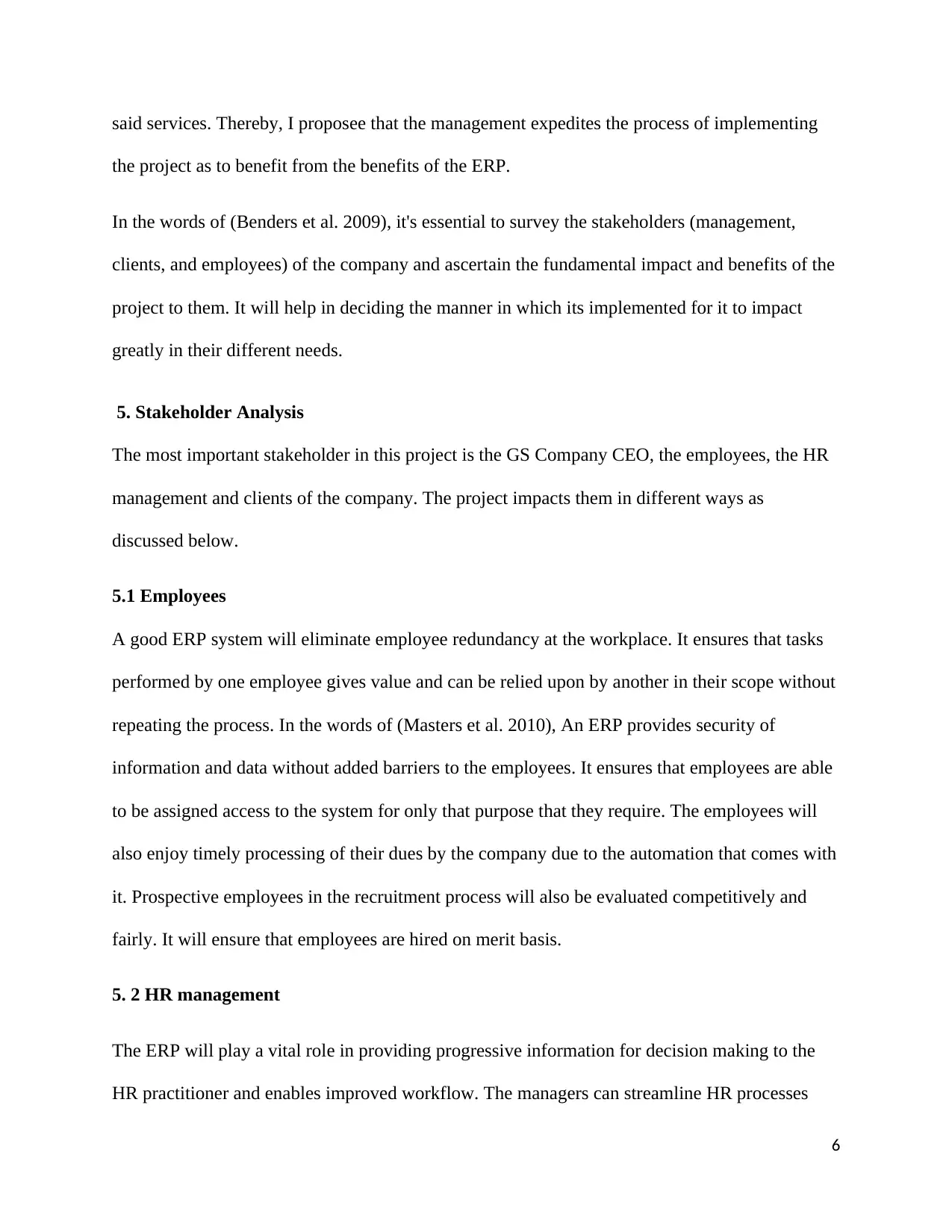
said services. Thereby, I proposee that the management expedites the process of implementing
the project as to benefit from the benefits of the ERP.
In the words of (Benders et al. 2009), it's essential to survey the stakeholders (management,
clients, and employees) of the company and ascertain the fundamental impact and benefits of the
project to them. It will help in deciding the manner in which its implemented for it to impact
greatly in their different needs.
5. Stakeholder Analysis
The most important stakeholder in this project is the GS Company CEO, the employees, the HR
management and clients of the company. The project impacts them in different ways as
discussed below.
5.1 Employees
A good ERP system will eliminate employee redundancy at the workplace. It ensures that tasks
performed by one employee gives value and can be relied upon by another in their scope without
repeating the process. In the words of (Masters et al. 2010), An ERP provides security of
information and data without added barriers to the employees. It ensures that employees are able
to be assigned access to the system for only that purpose that they require. The employees will
also enjoy timely processing of their dues by the company due to the automation that comes with
it. Prospective employees in the recruitment process will also be evaluated competitively and
fairly. It will ensure that employees are hired on merit basis.
5. 2 HR management
The ERP will play a vital role in providing progressive information for decision making to the
HR practitioner and enables improved workflow. The managers can streamline HR processes
6
the project as to benefit from the benefits of the ERP.
In the words of (Benders et al. 2009), it's essential to survey the stakeholders (management,
clients, and employees) of the company and ascertain the fundamental impact and benefits of the
project to them. It will help in deciding the manner in which its implemented for it to impact
greatly in their different needs.
5. Stakeholder Analysis
The most important stakeholder in this project is the GS Company CEO, the employees, the HR
management and clients of the company. The project impacts them in different ways as
discussed below.
5.1 Employees
A good ERP system will eliminate employee redundancy at the workplace. It ensures that tasks
performed by one employee gives value and can be relied upon by another in their scope without
repeating the process. In the words of (Masters et al. 2010), An ERP provides security of
information and data without added barriers to the employees. It ensures that employees are able
to be assigned access to the system for only that purpose that they require. The employees will
also enjoy timely processing of their dues by the company due to the automation that comes with
it. Prospective employees in the recruitment process will also be evaluated competitively and
fairly. It will ensure that employees are hired on merit basis.
5. 2 HR management
The ERP will play a vital role in providing progressive information for decision making to the
HR practitioner and enables improved workflow. The managers can streamline HR processes
6
⊘ This is a preview!⊘
Do you want full access?
Subscribe today to unlock all pages.

Trusted by 1+ million students worldwide

and monitor employees even while they are in the field (Grabot et al. 2008). It enhances
transparency among those entrusted with employees affairs within the company due to the
availability of real-time and verifiable data o employees.
5.3 Clients
A satisfied customer ensures that an organization stays afloat by continued business engagement
(Worster et al. 2012). An effective ERP will improve how the company engages the clients
regarding the human resource. It ensures that information presented to the client is up to date.
6.0 Organisational Fit Analysis
Due to the large number of employees in the company, which is also service based, the idea of an
ERP in managing the human capital is long overdue. Other organizations have incorporated the
same in their operations and proved to meet expectations.
7.0 Financial fit Analysis
7.1 First Year
Current costs associated with the current HR process
Outsourced services: payroll and monitoring fees-$11,000 annually + hiring fees of $2500
annually= $13,500
Salaries paid for redundancy services within the organization = $18000
Estimated loss in wrongfully claimed working hours =20,000
Total costs = $51,500
Costs associated with the implementation of the new ERP System.
Hardware and software module development and installation = $65,000
7
transparency among those entrusted with employees affairs within the company due to the
availability of real-time and verifiable data o employees.
5.3 Clients
A satisfied customer ensures that an organization stays afloat by continued business engagement
(Worster et al. 2012). An effective ERP will improve how the company engages the clients
regarding the human resource. It ensures that information presented to the client is up to date.
6.0 Organisational Fit Analysis
Due to the large number of employees in the company, which is also service based, the idea of an
ERP in managing the human capital is long overdue. Other organizations have incorporated the
same in their operations and proved to meet expectations.
7.0 Financial fit Analysis
7.1 First Year
Current costs associated with the current HR process
Outsourced services: payroll and monitoring fees-$11,000 annually + hiring fees of $2500
annually= $13,500
Salaries paid for redundancy services within the organization = $18000
Estimated loss in wrongfully claimed working hours =20,000
Total costs = $51,500
Costs associated with the implementation of the new ERP System.
Hardware and software module development and installation = $65,000
7
Paraphrase This Document
Need a fresh take? Get an instant paraphrase of this document with our AI Paraphraser
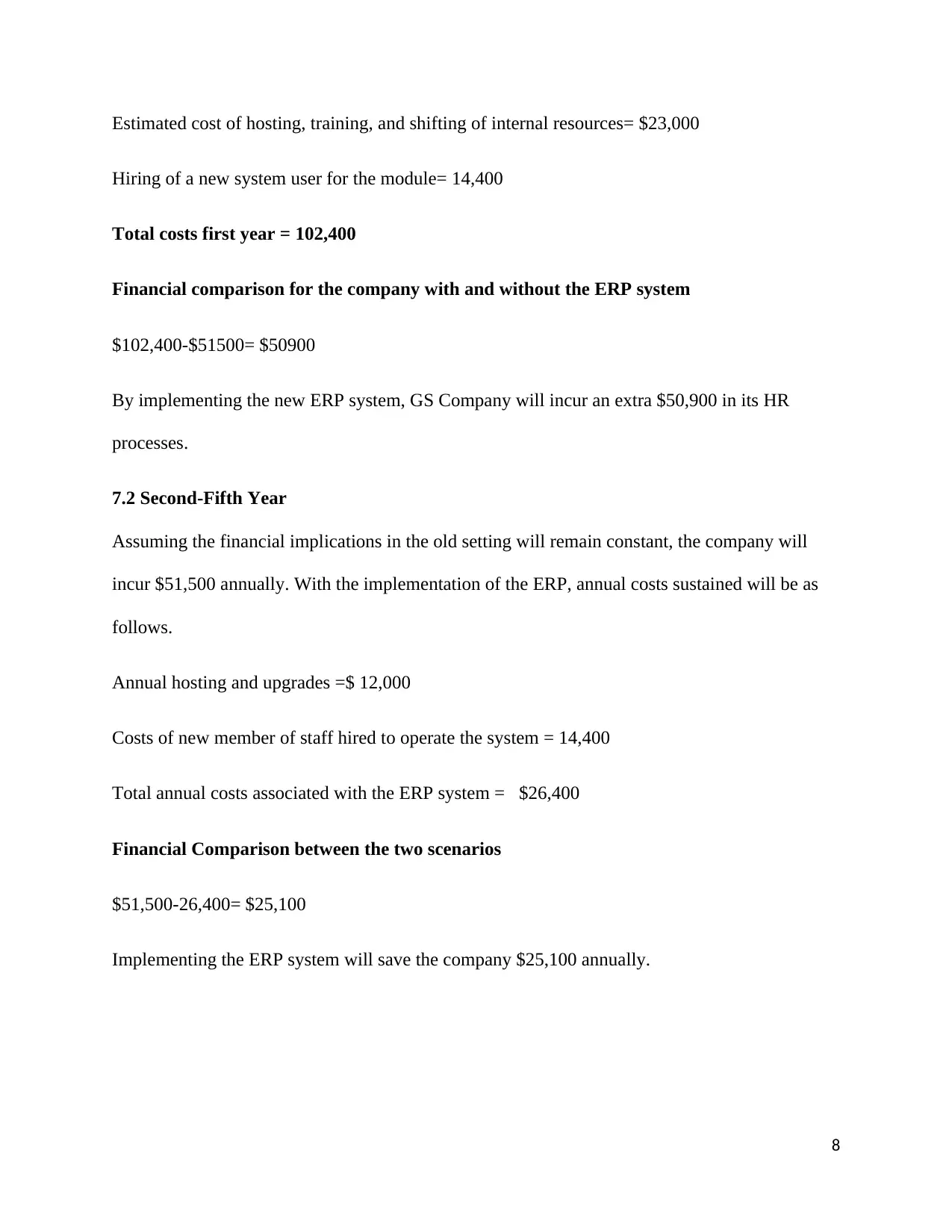
Estimated cost of hosting, training, and shifting of internal resources= $23,000
Hiring of a new system user for the module= 14,400
Total costs first year = 102,400
Financial comparison for the company with and without the ERP system
$102,400-$51500= $50900
By implementing the new ERP system, GS Company will incur an extra $50,900 in its HR
processes.
7.2 Second-Fifth Year
Assuming the financial implications in the old setting will remain constant, the company will
incur $51,500 annually. With the implementation of the ERP, annual costs sustained will be as
follows.
Annual hosting and upgrades =$ 12,000
Costs of new member of staff hired to operate the system = 14,400
Total annual costs associated with the ERP system = $26,400
Financial Comparison between the two scenarios
$51,500-26,400= $25,100
Implementing the ERP system will save the company $25,100 annually.
8
Hiring of a new system user for the module= 14,400
Total costs first year = 102,400
Financial comparison for the company with and without the ERP system
$102,400-$51500= $50900
By implementing the new ERP system, GS Company will incur an extra $50,900 in its HR
processes.
7.2 Second-Fifth Year
Assuming the financial implications in the old setting will remain constant, the company will
incur $51,500 annually. With the implementation of the ERP, annual costs sustained will be as
follows.
Annual hosting and upgrades =$ 12,000
Costs of new member of staff hired to operate the system = 14,400
Total annual costs associated with the ERP system = $26,400
Financial Comparison between the two scenarios
$51,500-26,400= $25,100
Implementing the ERP system will save the company $25,100 annually.
8

Year 1 Year 2 Year 3 Year 4
$0
$20,000
$40,000
$60,000
$80,000
$100,000
$120,000
Cost of the exixting HR system. Costs associated with the new system
Figure 1: Year HR costs depending on the system used
7.3 Five year Prediction
The five year estimated benefits would be as follows;
Year 1: -$50,900
Year 2: $26,400
Year 3: $26,400
Year 4: $26,400
Year 5: $26,400
9
$0
$20,000
$40,000
$60,000
$80,000
$100,000
$120,000
Cost of the exixting HR system. Costs associated with the new system
Figure 1: Year HR costs depending on the system used
7.3 Five year Prediction
The five year estimated benefits would be as follows;
Year 1: -$50,900
Year 2: $26,400
Year 3: $26,400
Year 4: $26,400
Year 5: $26,400
9
⊘ This is a preview!⊘
Do you want full access?
Subscribe today to unlock all pages.

Trusted by 1+ million students worldwide
1 out of 18
Related Documents
Your All-in-One AI-Powered Toolkit for Academic Success.
+13062052269
info@desklib.com
Available 24*7 on WhatsApp / Email
![[object Object]](/_next/static/media/star-bottom.7253800d.svg)
Unlock your academic potential
Copyright © 2020–2025 A2Z Services. All Rights Reserved. Developed and managed by ZUCOL.




